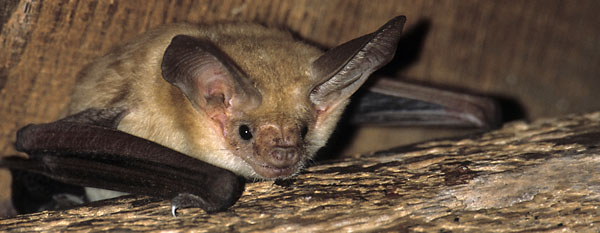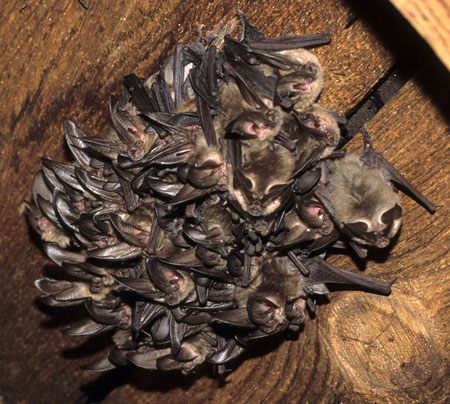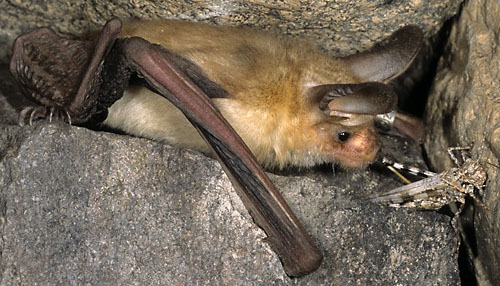home | internet service | web design | business directory | bulletin board | advertise | events calendar | contact | weather | cams

|
 A pallid bat from the lower Methow. These southwestern bats were discovered here by Dana Visalli in September 1997. Photo by Roberta Olenick. A pallid bat from the lower Methow. These southwestern bats were discovered here by Dana Visalli in September 1997. Photo by Roberta Olenick.The smallest bat found in the Methow is the California bat—about the weight of one penny. The most common here is the little brown bat. That's part of what a crowd of about 40 learned from Forest Service biologist Kent Woodruff at a recent program at North Cascades Base Camp. “The answer to almost everything about bats is ‘I don’t know’,” said Woodruff at the start of his program. Then he went on to explain what he has learned in his decade of local bat study – quite a bit it seems, but still only a little of what could be known. “They were very creative when they named the bats,” Woodruff joked. Other Methow Valley bat species are pallid, big brown, Yuma, long-eared, fringed, hoary, Townsends, small-footed, silver-haired, long-legged, spotted and—maybe--the canyon bat. Woodruff isn’t claiming the canyon bat as local until it is identified more certainly here. Researchers know little about the movements of bats, since they are too delicate to be banded. The Methow bats are too small to carry transmitters that can broadcast their locations. “We have no idea where the bats go in wintertime,” Woodruff said. What bats need for their amazing metabolisms is to hibernate “close to freezing but not freezing.” Just a hole in the ground or a cave is not enough. The ground is 51 degrees Fahrenheit, and bats need to find a safe place that’s colder—maybe a cave with ventilation to the cold outside.  Townsend's big-eared bats in a nursery colony group in the "Rattlesnake House" protected by Ted Wagner and Tom Campion in 1999 through a cooperative conservation effort to preserve this roost site. Photo by Roberta Olenick. Townsend's big-eared bats in a nursery colony group in the "Rattlesnake House" protected by Ted Wagner and Tom Campion in 1999 through a cooperative conservation effort to preserve this roost site. Photo by Roberta Olenick.The heart-rates of the little brown bats tell the story: at full-out pursuit of insects, the bat’s heart will run at 1,200 beats per minute. Resting is more like 200 to 300. But when they shut down for the winter to go seven months without eating and with very low body temperature, the rate drops to about 4 beats per minute. They breath like someone with bad sleep apnea---long times with no motion, then a few gasps before subsiding again. The best places to see local bats - in the summer - are under bridges or in mines, old buildings or forests with big trees. The most successful bat nursery here is a colony of about 100 Townsend’s big-eared bats in the upper Methow Valley. The nursery is in a 24 by 30 foot house with multiple rooms protected since 1999 by Ted Wagner and Tom Campion especially for bats. Bats are prodigious insect eaters. An audience member asked Woodruff if bats could minimize spruce bud worm and the tussock moth damage to Methow Valley forests. Woodruff seemed sure that local bats do eat tussock moths, but couldn’t definitively quantify just how helpful they are. “I don’t know,” he reminded the audience.  A pallid bat prepares to dine on a grasshopper. Photo by Roberta Olenick. A pallid bat prepares to dine on a grasshopper. Photo by Roberta Olenick.Woodruff went on to talk about bats outside the Methow---1,000 species worldwide. That means one fourth of the world’s mammals are bats, which “echolocate, hibernate, lactate, gestate, masticate, defacate and migrate.” The tiniest bat is the bumble bee bat—its name suggests its size. Flying fox bats, with wing spans of about six feet, live in the Phillipines. But not to fear: there are only three species of blood-licking bats and they are not nearly that size. Woodruff says they don’t really bite and suck. It’s more like scratching until blood oozes and then licking.
Woodruff explained what it takes to conserve a species in place:
Woodruff ended the program with a poem, by Noe Marymor. She was inspired to write the poem in 2000, when she was working with Woodruff researching bats in the Methow Valley.
8/8/11 |